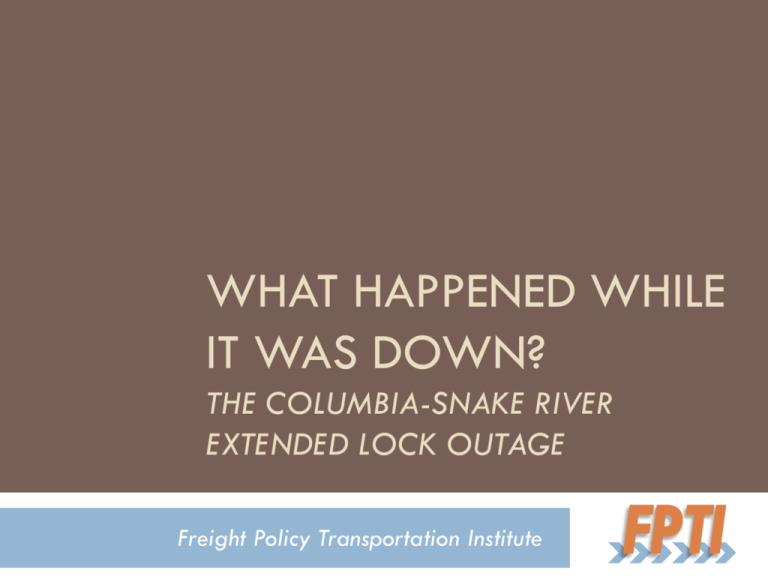Sara_Ken
advertisement

WHAT HAPPENED WHILE IT WAS DOWN? THE COLUMBIA-SNAKE RIVER EXTENDED LOCK OUTAGE Freight Policy Transportation Institute Transportation Disruption (Investment) Study Purpose Evaluate the economic and environmental impacts Determine Historical use of the river system Preparations of industry and government entities Impacts of the outage Return of traffic to the river system Produce a guide for other planned disruptions Industry Impacts of the Lock Outage Phase III Objectives To learn how the actors were impacted To describe the major commodity movements by rail and truck during the lock outage Data Sources Shippers, government divisions, industry personnel and ports U.S. Army Corps of Engineers’ Waterborne Commerce Statistics Center Rail and Truck Movements, December 2010 - March 2011 (Lock Outage) Data Sources Industry representatives Most notable finding: most products were transported by truck or a combination of truck and rail Most industries planned to only use rail Inexpensive and can transport large volumes Due to the convenience of truck Industries chose to send their goods to alternative markets Short distances and small loads Rail and Truck Movements, December 2010 - March 2011 (Lock Outage) Commodity Mode Tonnage Gasoline Truck and Rail 184,192 Distillate Fuels Truck and Rail 276,287 Rail 1,500 Truck and Rail 58,283 Sand, Gravel and Stone --- 0 Iron Ore and Steel Waste Rail 9,000 Smelted Products --- - Truck and Rail 45,648 Truck 212 Truck and Rail 31,194 Truck 68,250 Fertilizers Forest Products Wheat Corn, Rye, Barley, Rice and Oats Agricultural Products Waste Materials Barge Movements, December 2010 – March 2011 (Lock Outage) A portion of the river worked: from the pool west of The Dalles to Portland Bonneville Lock and Dam Downriver: A total of 377,000 tons were shipped downriver 4 major commodities 79% below average Wheat; forest products; sand, gravel and stone; and smelted products Manufactured equipment and machinery traveled upriver Gate leaves constructed for The Dalles Lock and Dam Pacific Northwest Wheat Case Study Background Wheat is the largest volume commodity that moves on the Columbia-Snake River 75 percent of all downriver movements The Pacific Northwest has a 3 pronged transportation system Purpose To capture the options and decisions of wheat elevator managers To provide a baseline scenario to compare changes brought on by the lock outage Bushels of Wheat Shipped by Survey Respondents, Dec 2010 – Mar 2011 Region Total Bushels Shipped Actual Percentage of Bushels Shipped Typical Percentage of Bushels Shipped Eastern Oregon 9,680,000 27% 12% Northern Idaho 2,430,000 7% 16% Southern Idaho 1,620,000 5% 3% No. Washington 20,320,000 57% 34% So. Washington 1,430,000 4% 35% Pacific Northwest 35,480,000 100% 100% Percentage of Wheat Shipped via Various Modes, Dec 2010 – Mar 2011 100% Truck 90% Barge 80% Rail 70% 60% 50% 40% 30% 20% 10% 0% Eastern Oregon Northern Idaho Southern Idaho Northern Washington Southern Washington Percentage of Wheat Shipped Via Various Transportation Modes Average Outage Average Outage Average Outage Region Truck Truck Barge Barge Rail Rail Eastern Oregon 1.0% 40.4% 91.8% 20.0% 7.2% 39.6% Northern Idaho 0.3% 2.0% 78.9% 0.0% 20.8% 98.0% Southern Idaho 33.3% 6.0% 21.7% 0.0% 45.0% 94.0% No. Washington 14.0% 14.1% 14.6% 0.0% 71.4% 85.9% So. Washington 0.9% 75.3% 97.5% 0.0% 1.6% 24.8% December - March Shipping Rates for Wheat by Survey Respondents, Dec 2010 – Mar 2011 Region Average Rate in Cents per Bushel (to Portland) Truck Truck-Barge Rail Eastern Oregon $0.56 $0.30 $0.54 Northern Idaho $1.50 - $0.74 Southern Idaho $0.76 - $0.90 No. Washington $0.45 - $0.55 So. Washington $1.34 - $0.58 Pacific Northwest $0.92 $0.30 $0.66 Rates before the lock outage: Truck - $0.89 (3.4% ↑) Rail - $0.65 (1.5% ↑) Wheat Industry Impacts Wheat Industry Increased truck and rail shipments Total shipments decreased by 1.6 million bushels High prices and demand during Fall 2010 Waited for locks to open Some firms expressed concern with rail service 4 elevators halted all wheat shipments Truck and rail were too expensive Shipped in anticipation of lock outage Barge shipments in summer and fall: 32% above average 1 elevator in Oregon had barge access Willamette Valley production Shipping Impacts and Activities Barge Line Impacts Laid off employees Reduced employees’ work hours Continued service below The Dalles Barging tugs were called to Portland Rail Line Impacts Increased cargo loads (going east and west) Increased employees’ hours to handle large loads and increased railcar numbers Increased fuel and employees’ costs Industrial Impacts and Activities Petroleum companies Reserved about procedures: proprietary information Shipped about 60% of product by tanker truck More economical and convenient than rail No pipeline use “Smooth sailing” No reported fuel shortages, price gouging or price hikes due to the lock outage Weekly Gasoline Prices, December 2010 – March 2011 All prices in the Pacific Northwest rose in unison. Rising gas prices were not an effect of the lock outage, but rather a result of unrest in the Middle East. Industrial Impacts and Activities Forestry Industry Truck and rail transportation (15% by rail) Paper firms used forest products from Eastern Washington and from local sources Barge lines were able to continue shipments From Barge Bingen, WA shipments during the summer and fall were 75% above average Allowed a build up of inventories The Rest of the Story Document the return of traffic to the river Calculate total costs to shippers and commodity industries Calculate energy and emission impacts of lock outage Questions? Check out the Freight Policy Transportation Institute’s website! Sara Simmons svsimmons@wsu.edu (509) www.fpti.wsu.edu 335-5536 Dr. Ken Casavant casavantk@wsu.edu (509) 335-1608



![lecture_8_(2)lscm[1] - Head Scratching Notes](http://s2.studylib.net/store/data/005495268_1-06056aa40ae4298d0ab041c29bbcab92-300x300.png)
